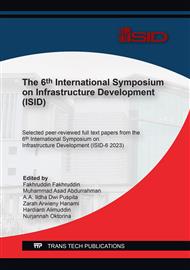[1]
G. Asok, S. George, Investigation on Hybrid Concrete Using Steel and Polypropylene Fibre, Int. J. New. Tech. Res. 2 (2021) 61-64.
Google Scholar
[2]
A. Fernandez, Y. Leung, Technology Roadmap Low Carbon Transition in The Cement Industry (2018) 28-46.
Google Scholar
[3]
M. S. Imbabi, C. Carrigan, and S. McKenna, Trends and Developments in Green Cement and Concrete Technology, Int. J. Sust. Built. Env. 1 (2012) 194–216.
DOI: 10.1016/j.ijsbe.2013.05.001
Google Scholar
[4]
J. Davidovits, Chemistry of Geopolymer System, Terminology. Proceedings of Geopolymer System, Int. Conf. France (1999).
Google Scholar
[5]
R. Irmawaty, Fakhruddin, and J. J. Ekaputri, Experimental and analytical study for shear strengthening of reinforced-concrete beams using a prefabricated geopolymer–mortar panel, Case Stud. Constr. Mater, 17, (2022), e01568.
DOI: 10.1016/j.cscm.2022.e01568
Google Scholar
[6]
N.F.R. Arifin, N.E. Nahdiyah, C. Efrein, M.F. Hidayat, R.D. Wardhana, F.Fakhruddin, The Utilization of Geopolymer Mortar as Permanent Formwork in Reinforced Concrete Beam, (2023) 143–149
DOI: 10.4028/p-d8g0ka
Google Scholar
[7]
D. Hardjito, S.E. Wallah, D.M.J. Sumajouw, B.V. Rangan, Fly Ash-Based Geopolymer Concrete, Aust. J. Struct. Eng. (6) (2005) 1-7.
DOI: 10.1080/13287982.2005.11464946
Google Scholar
[8]
Information on https://ikft.kemenperin.go.id/bgnl-3/
Google Scholar
[9]
M. Sofyan, A.O. Irlan, A. Rokhman, D.D. Purnama, R.R.R. Utami, The Effect of Using Linear Low Density Polyethylene (LLDPE) Powder and Rice Husk Ash on Compressive Strength and Intital Setting Time of Alkaline-Activated Mortar, IOP Conf. Earth. & Env. Sci. (2021) 1-8.
DOI: 10.1088/1755-1315/921/1/012070
Google Scholar
[10]
P. Lukowski, Polymer-Cement Composites Containing Waste Perlite Powder, J. Mater. (9) (2016) 1-9.
Google Scholar
[11]
O. Sengul, S. Azizi, F. Karaosmanoglu, M.A. Tasdemir, Effect of expanded perlite on the mechanical properties and thermal conductivity of lightweight concrete, in: Energy. & Build, 43, ResearchGate, 2011, pp.671-676.
DOI: 10.1016/j.enbuild.2010.11.008
Google Scholar
[12]
E.R. Vance, D.S. Perera, P. Imperia, D.J. Cassidy, J. Davis, J.T. Gourley, Perlite Waste as A Precursor For Geopolymer Formation, J. Aust. Cer. Soc. (45) (2009) 44-49.
Google Scholar
[13]
D. Hardjito, B.V Rangan, Development and Properties of Low-Calcium Fly Ash-Based Geopolymer Concrete, (2005) 13-24.
Google Scholar


